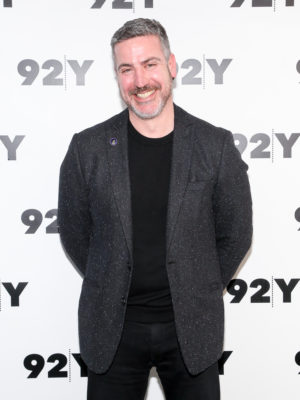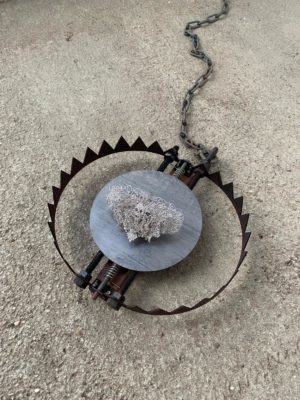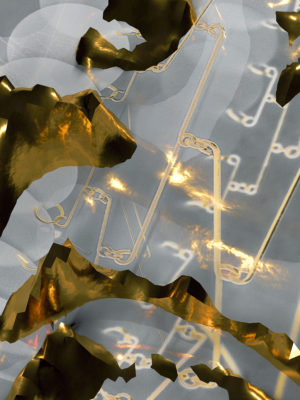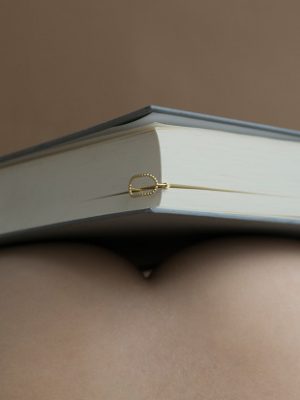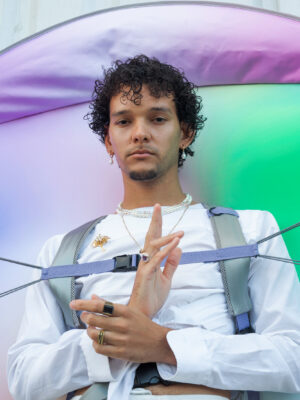Heidi Kreamer-Garnett
Today, you are such an influential voice in jewelry. How did you first find it?
Jonathan Wahl
I have an idiosyncratic relationship with jewelry. I discovered it as a sophomore completing my BFA [at Temple University’s Tyler School of Art]. I was taking a graphic design course, because I thought that was what I wanted to do, and I did not like it. I took some jewelry classes and found them fascinating. They were hands on and materially based, which was exciting. There was so much to learn in terms of a skill and a craft.
Stanley Lechtzin, who was the director of the program, was very career oriented. There was a feeling that you could be a costume jewelry designer and move to New York City. Coming from an all-boys prep school and as a 19-year-old in art school, that sounded very glamorous. I am going to counter this later on but, at the time, I was not ready to be an artist and I did not think that was a viable career.
What is an example of one of the pieces of jewelry you made during your BFA?
One assignment was to make a set of jewelry inspired by a song. I chose the B-52’s “Planet Claire.” You know, “Planet Claire has pink air, all the trees are red, no one ever dies there, no one has a head.” I made cast resin brooches of the planets and arranged them around an anodized space capsule containing an image of a friend wearing a crazy Louis XIV wig. It was fun and kooky. The great thing about Tyler was having the opportunity for this sort of material investigation.
I love “Planet Claire!” What was your path from the B-52s to the 92Y?
As an undergraduate student, I started moving towards sculpture. I wanted to go to graduate school and to one that was based in art, which is why I chose SUNY New Paltz. After graduate school, I moved to Germany to be an artist resident for a year and made objects of sculpture. From there, I moved to New York City and began working at the Craft Students League, eventually becoming Assistant Director of the program and director of the Jewelry Studios.
What I learned during this time was that most jewelers I knew in the US trained in art schools. Unless you go to art school, you generally don’t have access to any of those hard skills. Where do you go to learn to be a great wax carver or stone setter? I became interested in building a place where someone could construct this more technical skillset. It’s something people don’t always get in art school and there aren’t many places to get it in the US.
Unlike in Europe, we don’t have trade schools. In Europe, there are much longer traditions of apprenticeship, guilds, and craftspeople. In the US, much of our education is post-World War II, so craft was subverted in a large way by modernism, which really rejected the decorative arts. Since then, we have been working our way back to traditional education.
That is what you have worked to build at the 92Y — a place where people can learn those “hard skills?”
We offer 60 classes a week and there are about 500 butts in seats each week. We have 24 different faculty and 20 different class topics that range from silversmithing to goldsmithing, stone-setting, wax carving, and more. I wanted to create a place where people could learn these skills and investigate jewelry.
I am seduced by people who have mastered a craft. There are great designers, but I am most amazed by people who have mastered a technique. That is so rare in our day and age. And these skills are important. They are thousands of years old; they are eternal and classic.
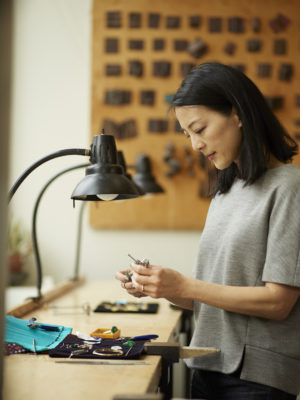
Have you ever tried your hand at being a jewelry designer yourself?
My current studio practice is not jewelry, but drawings which began as portraits of jet jewelry. I did create a line at one point and got a large spread in the now defunct W Jewelry. Bergdorf called, among others. There was so much interest. It was amazing and it was drama! I thought to myself, “I don’t know if this is what I want to do.” What I love is the process, craftsmanship, and making, but I did not want to be a business. It’s not where my soul was.
My soul is looking at objects from a more academic place. I come from art and jewelry made in that world. That being said, I do love all types of jewelry.
“I am seduced by people who have mastered a craft. There are great designers, but I am most amazed by people who have mastered a technique. That is so rare in our day and age. And these skills are important. They are thousands of years old; they are eternal and classic.”
In the past, you’ve mentioned an “underground mission” at the 92Y. Would you share some more about it?
New York City can be pretty conservative when it comes to jewelry. I want to introduce the city to some of the work that does not get seen here. Every year, I go to Munich Jewellery Week. It’s an amazing explosion of material investigation by artists from all over the world who we usually do not see here. They are making work that is very challenging, at times, but very beautiful and, I am going to say my favorite word, chic.
One of the challenges in New York City is that there are four galleries in our region that represent studio jewelry [Sienna Patti, Jewelers’ Werk, Ornamentum, and Gallery
Loupe]. None of them are in the city. One exception is the Jeanne Greenberg at Salon 94, which shows amazing jewelry by Karl Fritsch. You cannot stumble over studio jewelry; you have to look for it.
How are you working on this mission at the 92Y?
We have an incredible platform at the 92Y. What I love is being able to present and engage people in so many different layers of jewelry. One important initiative is the artist-in-residence program. For a month during the summer, the residency gives an artist an opportunity to develop a body of work or complete research while living in New York City. The idea is to allow them to absorb the city and also to expose the city to them. Our most recent resident was Claudia Lepik, an Estonian jeweler who is exploring face jewelry. We also have a series of talks, including a very popular one led by editor in chief Stellene Volandes, events, trips, and, of course, all our courses.
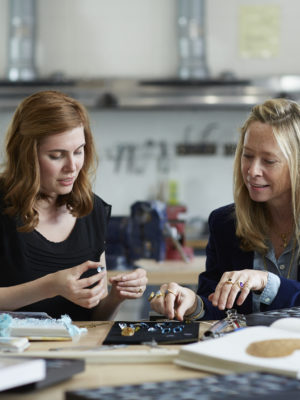
What are you most excited about in 2020?
Every year, I take a group of donors and collectors somewhere new. Next year, we are taking a trip to Korea, which will be fascinating.
Wow, can I come along? I must admit I don’t know much about the jewelry scene in Korea. Why did you choose it?
There are many Korean artists who studied for a time abroad. Today, there are probably three generations of artists, who were trained either in Europe or the States and are now teaching in Korea. I’m excited to visit them and to see the cross-cultural pollination.
These trips are about decorative arts in general. So, the itinerary speaks to my love for skills in areas like textile and
woodwork, as well as jewelry. The jewelers we are visiting include the likes of Yong-il Jeon, who is a senior lecturer at Kookmin University, Jung-gyu Yi, and Najin Lee.
Also, we just finished with our third artist in residency, which is very exciting. We are getting ready to announce an open call for 2020 submissions during December and to start looking at a new artist coming here. We have had three artists from Europe and, while that’s fantastic, I would be thrilled to have an artist from farther afield next year.
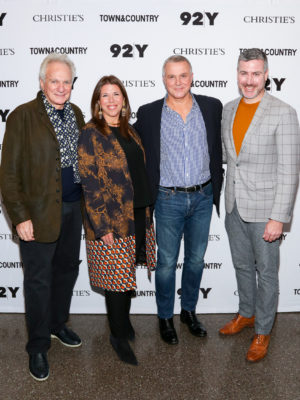
Is there anything on your wish list at the 92Y?
I think there’s an incredible opportunity to teach jewelry skills to high school kids in this city. We currently offer classes for students from the ages of 8 to 18 after school and on weekends. But those are limited and not very accessible to kids who are not in great school districts with great art departments.
Something I often think about is: how does the jewelry world sustain itself and how do we get people into the pipeline earlier? It isn’t only about creating a new generation of jewelers. Whether or not kids become jewelers, they should have the experience of learning a skill like soldering.
Soldering is an amazing experience. There’s something cathartic about melting and making.
Yes, and it’s something most people never get to do. Ask your friends: have you ever held a torch? Not many have. Playing with fire is pretty empowering. And certainly, within the urban environment, jewelry is a very potent form of expression and always will be. There’s an opportunity there.
Shifting gears, let’s get a little jewelry nerdy. What is your favorite gemstone?
Banded agate. It is eternal; it has been in the tombs of pharaohs and worn by the Greek gods. It is a snapshot of time. Those bands of materials went down one at a time. When holding a bead, you are holding in your hand a time capsule that could represent 1,000 years in your hand.
Now for an easy question: favorite piece of jewelry ever?
Hard! One of my favorite pieces of contemporary jewelry is Otto Künzli’s wedding ring necklace. It sums up what I love about jewelry. It is a circular chain made out of wedding rings. He bought each band at a pawn shop and then linked them into a chain.
The necklace is beautiful, sad, and poetic. The wedding ring is often viewed as a regular, everyday object. So many people have one. Yet, it represents such an important moment in peoples’ lives and such intimacy. I love Mr. Künzli’s idea of linking together all these objects, each representing a singular moment for two people, to create a chain that becomes a new piece of jewelry. I’ve joked that if Death (you know, the guy with the hood and sickle) wore a necklace, this would be his necklace. Laughing aside, the necklace never stops speaking to me about the power of jewelry.
Who are some designers you are watching?
Definitely Claudia Lepik, who I mentioned earlier. [For more information on Claudie Lepik’s residency at 92Y, check out our interview with her] Ariana Boussard-Reifel, who took classes at the 92Y and has now had jewelry worn by Beyoncé. Lin Cheung, whose work is beautiful and very materially-based. Jiro Kamata, who creates pieces that are challenging in their simplicity. Bettina Speckner, whose work speaks to
me personally.
Leading the jewelry social club Gem X with my co-founder Lin Jamison, we have seen such an appetite among people to have personal experiences with jewelry. Especially with all your experience at the 92Y, is this something you are also seeing?
Jewelry is intimate. It is experiential and it is personal. You wear jewelry on your body. Today, the world is filled with images that you whisk through on platforms like Instagram at 1,000 miles a minute. Whether it is taking a jewelry-making class or having a jewelry experience through a group like Gem X, I think people want to slow down and find that intimacy.
Maybe it’s in the zeitgeist and maybe it’s also a more romantic idea. I think the intimacy of jewelry is potent. Look, the reason we love gems is because they sparkle, and they sparkle like our eyes. Our eyes are the most intimate point of connection for human beings. You look into someone’s eyes when you are in love with them. That is why we love gemstones. We will always love jewelry. While styles will change, we will always admire West African gold and the English Crown Jewels. Jewelry is eternal and we will always have these touchstones. While the world will be tweaked, we will never leave this world behind us.
It’s such an exciting opportunity to run a program where people can find that intimacy and make things. Jewelry was one of our first art forms, alongside cave painting. I mean, we get to teach people how to make things. How amazing is that?!
To view the full offering of the 92Y Jewelry Center, visit: https://www.92y.org/soa/jewelry
Heidi Kreamer-Garnett is co-founder of the jewelry social club Gem X, a contributor on jewelry to The ‘Wall Street Journal’ and a designer; she splits her time between London and New York City, and you can follow her journeys on Instagram @heidikreamergarnett.
This article is published in the 2019 New York City Jewelry Week Paper, the result of a collaboration between Current Obsession and NYCJW.
